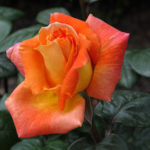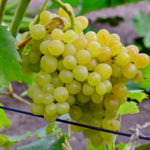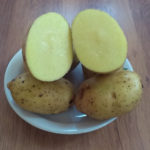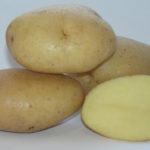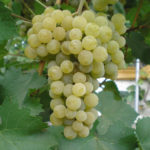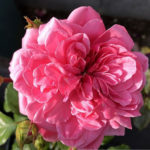Pear variety Talgar beauty
Talgar beauty - a pear of Kazakh selection with the fruits of the autumn ripening period. Derived from seeds from free pollination of a Belgian variety Forest beauty... Place of hatching: Kazakh Research Institute of Fruit and Viticulture. The author of the variety: breeder A.N. Katseiko. The variety has been assigned a selection number of 1-20 / 13. Since 1960, the pear has been on the State test. In 1991, the variety was zoned in the North Caucasus region (Kabardino-Balkarian Republic). The Talgar beauty was most widespread among amateur gardeners in the Krasnodar and Stavropol Territories, as well as in Ukraine.

The trees are of medium size, the crown is medium-leafy, wide-pyramidal, with hanging branches. Skeletal branches, when leaving the trunk, form an angle close to right. The bark on the main branches and trunk with peeling, painted gray. Fruit setting occurs most often on the ringlets.
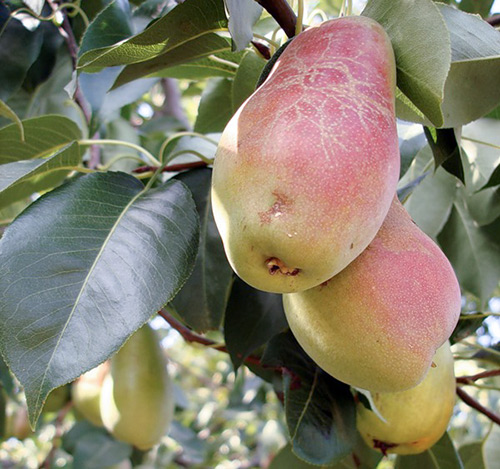
Shoots are medium in thickness, straight, without pubescence, brown in color. Lentils of medium size, distinct, numerous. The buds are large, pressed, conical in shape, hairiness is absent. The leaves are large, ovoid in shape, with long-pointed tips and finely serrated serration along the edges, painted in a dark green color. The leaf blade is smooth, shiny, without pubescence, with slight venation and slight concavity in the form of a “boat”. The petioles are long.
Flowering occurs in medium terms. The best pollinators for the Talgar beauty pear can be varieties: Hoverla, Conference and Lyubimitsa Klappa.

Fruits grow above average size: the weight usually ranges from 140 to 200 g, but averages 170 g, the largest single specimens can reach 250 g. The fruits are not always aligned, elongated pear-shaped, bottle-shaped, with a sloping top. The skin is of medium thickness, smooth, oily, without rustiness, with a glossy sheen; the main color is pale yellow, the integumentary color is expressed on most of the surface of the fruit in the form of a blurred bright red-carmine blush on the sunny side. Subcutaneous dots of small size, numerous, clearly visible, green on the skin without integumentary coloration, white on the illuminated part of the fruit. The stalks are medium in thickness and length, slightly curved in shape. The funnel is very small, in some fruits it is completely absent. The saucer is rather deep, narrow, and smooth. Open cup. The heart is of medium size, elliptical in shape. Seed chambers are small, closed.
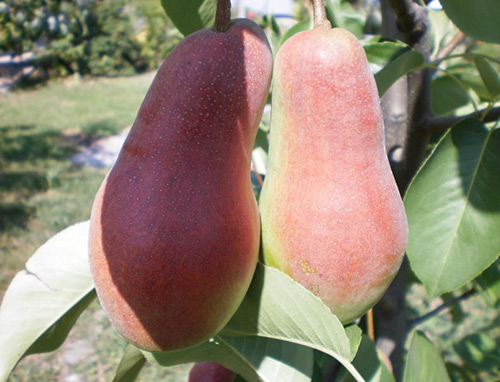
The pulp has a creamy color, medium density and fine-grained structure. Pears have a very good taste and will especially appeal to those with a sweet tooth and children, as they are incredibly juicy, crunchy, aromatic and very sweet. Taste qualities are completely determined by the predominance of sugars in fruits over acids. According to the chemical composition, pears contain (under the conditions of the Kuban): the sum of sugars (9.0%), titratable acids (0.37%), dry substances (15.0%), ascorbic acid (7.0 mg / 100 g) , P-active catechins (per 100 g of raw substance 54.0 mg). Talgar beauty belongs to table varieties.
The period of removable ripeness of fruits falls at the end of September, the consumption period begins from October - November. The storage period is 2 months. In a cool room, pears are stored until December. In a refrigerator, fruits can last until February. No spots appear on the skin while lying down. For longer storage, it is recommended to harvest slightly unripe (i.e.a little earlier than the due date). The variety is not prone to shedding, ripe fruits are firmly held on the branches even with strong gusts of wind and are not damaged when pressed. Despite this circumstance, late harvesting is highly undesirable due to the possible loss of taste and the likelihood of dark spots appearing on the skin, especially for a long period of storage. Although some gardeners noted that the "late" fruits (taken at the first frost) are also distinguished by delicious taste and incredible juiciness. Transportability is good.
The variety is fast-growing, the trees bear fruit in 4-5 years, although often the first fruits (in the amount of 2 to 3 pieces) are formed earlier (by 2 to 3 years). Fruiting is annual, abundant, the volume of the harvest increases rapidly with each subsequent year. Indicators of winter hardiness and drought resistance are quite high. Resistance to fungal diseases and pests is high.
In general, the Talgar beauty pear is considered unpretentious in care and does not require much labor. Its good compatibility with quince rootstocks was noted.
The main advantages of this pear are: attractive in appearance, very large fruits, beautiful in shape, with good taste; high rates of winter hardiness and scab resistance; good early maturity; high productivity; long storage period for fruits; good transportability.
And although no significant flaws have yet been found in the variety, for some it may be crispy flesh. Also, do not forget about the risk of browning the pulp in case of late harvesting of fruits.
